Antibody data
- Antibody Data
- Antigen structure
- References [2]
- Comments [0]
- Validations
- Western blot [8]
- Immunohistochemistry [1]
Submit
Validation data
Reference
Comment
Report error
- Product number
- PA5-29725 - Provider product page

- Provider
- Invitrogen Antibodies
- Product name
- CTH Polyclonal Antibody
- Antibody type
- Polyclonal
- Antigen
- Recombinant protein fragment
- Description
- Recommended positive controls: 293T, A431, HeLa, HepG2, mouse liver, rat liver. Predicted reactivity: Mouse (84%), Rat (85%), Pig (86%), Bovine (91%). Store product as a concentrated solution. Centrifuge briefly prior to opening the vial.
- Reactivity
- Human, Mouse, Rat
- Host
- Rabbit
- Isotype
- IgG
- Vial size
- 100 µL
- Concentration
- 1.02 mg/mL
- Storage
- Store at 4°C short term. For long term storage, store at -20°C, avoiding freeze/thaw cycles.
Submitted references Hydrogen sulfide, oxygen, and calcium regulation in developing human airway smooth muscle.
Cystathionine metabolic enzymes play a role in the inflammation resolution of human keratinocytes in response to sub-cytotoxic formaldehyde exposure.
Bartman CM, Schiliro M, Helan M, Prakash YS, Linden D, Pabelick C
FASEB journal : official publication of the Federation of American Societies for Experimental Biology 2020 Sep;34(9):12991-13004
FASEB journal : official publication of the Federation of American Societies for Experimental Biology 2020 Sep;34(9):12991-13004
Cystathionine metabolic enzymes play a role in the inflammation resolution of human keratinocytes in response to sub-cytotoxic formaldehyde exposure.
Lee E, Kim HJ, Lee M, Jin SH, Hong SH, Ahn S, Kim SO, Shin DW, Lee ST, Noh M
Toxicology and applied pharmacology 2016 Nov 1;310:185-194
Toxicology and applied pharmacology 2016 Nov 1;310:185-194
No comments: Submit comment
Supportive validation
- Submitted by
- Invitrogen Antibodies (provider)
- Main image
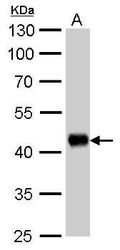
- Experimental details
- Western blot analysis of CTH using 50 µg rat liver lysate. Samples were loaded onto a 10% SDS-PAGE gel and probed with a CTH polyclonal antibody (Product # PA5-29725) at a dilution of 1:1000.
- Submitted by
- Invitrogen Antibodies (provider)
- Main image
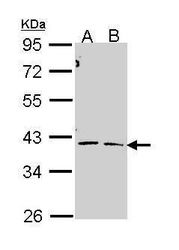
- Experimental details
- Western blot analysis of CTH using 30 µg of A) HeLa and B) MOLT4 lysate. Samples were loaded onto a 10% SDS-PAGE gel and probed with a CTH polyclonal antibody (Product # PA5-29725) at a dilution of 1:1000.
- Submitted by
- Invitrogen Antibodies (provider)
- Main image

- Experimental details
- Western blot analysis of CTH was performed by separating 50 µg of rat tissue extract by 10% SDS-PAGE. Proteins were transferred to a membrane and probed with a CTH Polyclonal Antibody (Product # PA5-29725) at a dilution of 1:3000. The HRP-conjugated anti-rabbit IgG antibody was used to detect the primary antibody.
- Submitted by
- Invitrogen Antibodies (provider)
- Main image
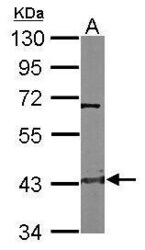
- Experimental details
- Western Blot using CTH Polyclonal Antibody (Product # PA5-29725). Sample (50 µg of whole cell lysate). Lane A: mouse liver. 10% SDS PAGE. CTH Polyclonal Antibody (Product # PA5-29725) diluted at 1:1,000. The HRP-conjugated anti-rabbit IgG antibody was used to detect the primary antibody.
- Submitted by
- Invitrogen Antibodies (provider)
- Main image
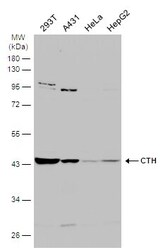
- Experimental details
- Western Blot using CTH Polyclonal Antibody (Product # PA5-29725). Various whole cell extracts (30 µg) were separated by 10% SDS-PAGE, and the membrane was blotted with CTH Polyclonal Antibody (Product # PA5-29725) diluted at 1:1,000. The HRP-conjugated anti-rabbit IgG antibody was used to detect the primary antibody.
- Submitted by
- Invitrogen Antibodies (provider)
- Main image
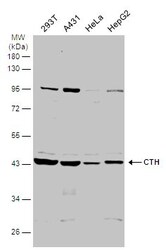
- Experimental details
- Western Blot analysis of CTH was performed by separating 30 µg of various whole cell extracts by 10% SDS-PAGE. Proteins were transferred to a membrane and probed with a CTH Polyclonal Antibody (Product # PA5-29725) at a dilution of 1:1000 and a HRP-conjugated anti-rabbit IgG secondary antibody.
- Submitted by
- Invitrogen Antibodies (provider)
- Main image
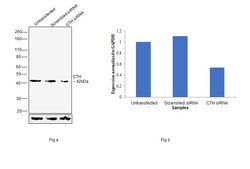
- Experimental details
- Knockdown of CTH was achieved by transfecting BeWo with CTH specific (Silencer® select Product # s3710, s3711). Western blot analysis (Fig. a) was performed using Modified whole cell extracts from the untransfected cells (Lane 1),non-specific scrambled siRNA transfected cells (Lane 2) and CTH knockdown cells (Lane 3). The blot was probed with CTH Polyclonal Antibody (Product # PA5-29725, 1:1000 dilution) and Goat anti-Rabbit IgG (H+L) Superclonal™ Recombinant Secondary Antibody, HRP (Product # A27036, 1:4000 dilution). Densitometric analysis of this western blot is shown i histogram (Fig. b). Loss of signal upon siRNA mediated knock down confirms that antibody is specific to CTH.
- Submitted by
- Invitrogen Antibodies (provider)
- Main image
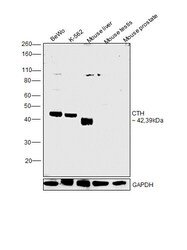
- Experimental details
- Western blot was performed using CTH Polyclonal Antibody (Product # PA5-29725) and a 42 kDa, 39 kDa band corresponding to CTH was observed in tested cell lines and tissue positive (liver) for CTH respectively. Whole cell extracts (30 µg lysate) of BeWo (Lane 1), K 562 (Lane 2), tissue extracts (30 µg lysate) of Mouse liver (Lane 3), Mouse testis (Lane 4) and Mouse prostate (Lane 5) were electrophoresed using NuPAGE® 4-12 % Bis-Tris gel (Product # NP0322BOX). Resolved proteins were then transferred onto a nitrocellulose membrane (Product # IB23001) by iBlot® 2 Dry Blotting System (Product # IB21001). The blot was probed with the primary antibody (1:1000 dilution) and detected by chemiluminescence with Goat anti-Rabbit IgG (H+L), Superclonal™ Recombinant Secondary Antibody, HRP (Product # A27036, 1:4000 dilution) using the iBright FL 1000 (Product # A32752). Chemiluminescent detection was performed using Novex® ECL Chemiluminescent Substrate Reagent Kit (Product # WP20005).
Supportive validation
- Submitted by
- Invitrogen Antibodies (provider)
- Main image
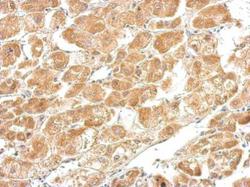
- Experimental details
- CTH Polyclonal Antibody detects CTH protein at cytosol on human hepatoma by immunohistochemical analysis. Sample: Paraffin-embedded hepatoma tissue. CTH Polyclonal Antibody (Product # PA5-29725) dilution: 1:500. Antigen Retrieval: EDTA based buffer, pH 8.0, 15 min.
 Explore
Explore Validate
Validate Learn
Learn Western blot
Western blot